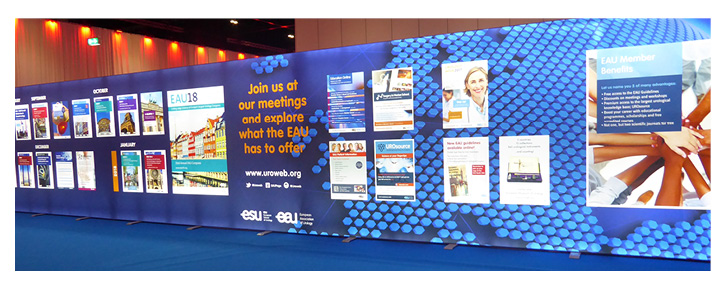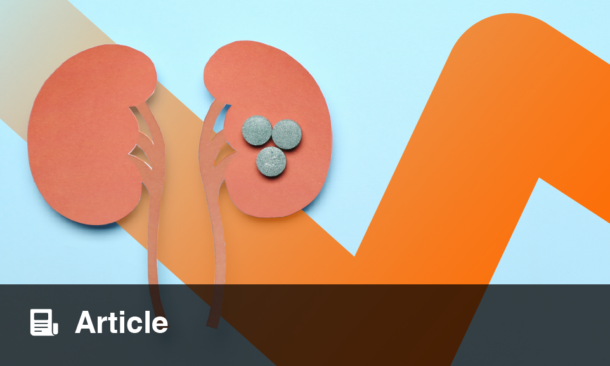The vibrant city of London was the location for this year’s Annual European Association of Urology (EAU) Congress, welcoming attendees from across the world with the traditional sounds of a marching band. Taking place over 5 days, the congress included plenary sessions as well as expert and technical sessions reflecting on the most recent developments across the field of urology. In addition, >1,100 abstracts were presented in the form of video presentations or posters during the event. Attendees kept track of everything they wished to participate in with the official EAU Pocket Events App, which also allowed attendees access to the scientific content following the event. In our congress review section, we bring you highlights of the congress to refresh your memory of or to inform those who were unable to attend about all the unmissable urological updates. In his official welcome, EAU Secretary General Prof Christopher Chapple summed up the collaborative nature of the event, stating: “The scale of activities makes our congress a one-stop event where you can connect not only with your colleagues but also create new professional contacts with top-notch researchers and specialists.”
In his remarks at the opening ceremony, Sir Bruce Keogh, NHS England’s Medical Director and Commissioner of the Commission for Health Improvement spoke of his pride in welcoming the attendees on behalf of the health service, noting: “at these events new ideas begin to take seed and take hold.” Sir Keogh cited: “increasing demand, rapidly escalating cost, changing public and professional expectations, and not enough money to serve everything,” as the fundamental problems facing healthcare systems around the world, and spoke of his admiration of the work done by EAU and partner associations to foster collaboration between different groups to address these issues and improve healthcare around the world. He also expressed his thanks to colleagues who were designing and developing the tools to allow surgeons and clinicians to bring these changes to their patients.
The opening ceremony also featured the award winners of the congress. This year the most prestigious award, the Willy Gregoir Medal, was bestowed upon Prof Paul Abrams, Department of Urology, University of Bristol, Bristol, UK, for his significant contributions to the development of the urological specialty in Europe. He commented in the European Urology Today Congress News that: “A challenge for urology is to carry the quality of European urology to the developing countries, and the EAU is doing a great job in starting that process.” Also recognised were Prof Per-Anders Abrahamsson, Department of Urology, Skåne University Hospital, Malmö, Sweden, who received the Frans Debruyne Lifetime Achievement Award for longstanding and important contribution to the activities and development of EAU, and Prof Christian Gratzke, Department of Urology, Ludwig-Maximilians-University, Munich, Germany, who was awarded the Crystal Matula for young promising European urologists. Alongside the awards, honorary member titles were given to Prof Shin Egawa (Japan), Prof Tomas Hanus (Czech Republic), Prof Vito Pansadoro (Italy), Prof Eduardo Solsona (Estonia), and Dr Patrick Walsh (USA). A selection of abstracts, papers, and videos were also recognised for their contributions to urology.
The topics covered by the presentations and symposiums were extensive and all-encompassing, with something for every attendee from across the board. In the following review highlights, we present to you the very best of the cutting-edge research and data from across Europe. We hope you will enjoy reading the EAU highlights, and very much look forward to seeing many of you in March 2018, at next year’s congress, due to be held in the beautiful city of Copenhagen, Denmark.

Biosensor Chips in the Fight Against Antibiotic Resistance
ANTIBIOTIC overuse and mistreatment is fast becoming a critical public health issue. Part of this can be attributed to the current delay in bacterial isolation and determination of their susceptibility to antibiotics currently available. As described in a EAU press release dated 24th March 2017, a novel technology utilising biosensor chips may be about to change this.
Shockingly, it is estimated that >9,000 patients die from bacterial infections each year in the UK, with 300,000 individuals acquiring such infections within a hospital setting. Across Europe, an annual incidence of >4 million patients developing healthcare-acquired bacterial infections has been reported. The high occurrence of bacterial infections and limitation in the number of effective antibiotics now left available has further augmented the problem of resistance. It is therefore pertinent that a swift, accurate method for diagnosis and treatment recommendation be developed.
Pioneering research led by Prof Ester Segal, Technion Israel Institute of Technology, Haifa, Israel, has trialled the implementation of silicon micropillar arrays in determining the most appropriate antibiotics for the treatment of Escherichia coli infection, the leading culprit for urinary tract infections. The silicon biosensor chips designed by the team contain thousands of coated nano wells, equipped to effectively trap the bacteria and allow a count to be calculated and growth measured. Various antibiotic dilutions are then added to each nano well with the aim to inhibit the growth of the colony, a process able to obtain results within just 2–6 hours, compared with the 2-day approach currently used.
Although it is early days, the team are hopeful that their system will be implemented within worldwide clinical practice. Prof Sarel Halachmi, Bnai Zion Medical Centre and Technion Israel Institute of Technology, Haifa, Israel, explained: “If our system can save an extra day in hospital, that alone will save at least $300 in most countries.”
New Approach for Prostate Cancer Screening
A NEW technique for prostate cancer (PCa) screening, based on magnetic resonance imaging (MRI), was presented at this year’s congress, as noted in a EAU press release dated 25th March 2017. The study’s lead author, Dr Arnout Alberts, Erasmus Medical Centre, Rotterdam, Netherlands, spoke excitedly about the potential of MRI-based screening, stating that: “This could change the balance of the equation.” Indeed, although PCa is the most common cancer in men worldwide, the current PCa screening method is a contentious one, as it is not felt to have the correct balance between lives saved and harm caused.
Currently, the screening approach begins with repeated measurements of prostate-specific antigen (PSA); if elevated PSA levels are found the next step is a transrectal ultrasound-guided random prostate biopsy (TRUS-biopsy). Typically, a fine needle is used to take 6–12 samples from the prostate. With this technique, there is a chance of discovering a small cancer that may not be clinically threatening, which could lead to unnecessary procedures due to overdiagnosis. Therefore, an improved method is of great importance.
Researchers studied outcomes in a group of heavily pre-screened men: it was acknowledged that this heavy pre-screening was a potential limitation of the study. Six TRUS-biopsy samples were taken from 177 men and 12 TRUS-biopsy samples were taken from a further 158. The 158 men in the latter group were first given an MRI scan and if the MRI scan detected a potentially suspicious area then additional MRI-targeted samples were taken. The findings suggested that while all methods had a similar detection rate for high-grade cancers, the MRI-targeted biopsy approach resulted in a significant reduction in the number of biopsies required. Overall, 70% of men did not require a biopsy and the MRI-targeted approach also saw the number who were overdiagnosed with a non-aggressive PCa cancer cut by ˜50%. Looking ahead, the researchers hope their findings will provide a stepping stone for confirmatory studies to attempt to reproduce these results and garner a deeper understanding of the statistics and cost-effectiveness of the method to determine whether it could be recommended for routine use in the future.

Test to Predict Those at Greatest Prostate Cancer Risk
A GENETIC test that predicts the patients most at risk from aggressive prostate cancer (PCa) and their likelihood of treatment failure was presented at the Annual EAU Congress, as reported in a EAU press release dated 26th March 2017.
Researchers investigated the Kallikrein (KLK) region of chromosome 19 in 1,858 patients with aggressive PCa (defined as having a Gleason Score >8); they searched for small single-point inherited mutations. Their findings revealed several variants of the KLK6 gene were associated with more aggressive PCa. Men with these gene variants were found to have a three- times greater risk of developing aggressive PCa. With these gene variants found in between 6% and 14% of men, this makes it one of the most common genes that has currently been found to be associated with aggressive PCa.
Furthermore, these inherited gene variants were found to independently predict treatment failure, based on a cohort of Canadian men from the International Cancer Genome Consortium (ICGC). Men with these gene variant mutations who had undergone radiation treatment or surgery were found to have a greater likelihood of recurrence: three-times greater than the rest of the population. The researchers noted that further sequencing studies could be of use in discerning rare variants that might have a major effect in the KLK6 region.
Speaking about the practical benefits of this test, lead study author Dr Alexandre Zlotta, Lunenfeld–Tanenbaum Research Institute, Toronto, Ontario, Canada, elucidated: “It should mean that if you have a high prostate-specific antigen level but are unsure about having a biopsy to confirm whether you have cancer, this test could help you decide. It also means that we can begin to look at better screening for those who are at risk, for example among those men with a family history. As the test is refined we may be able to move towards more intelligent prostate screening.”
Up to 40% of Prostate Cancer Patients Left Undertreated
MEN diagnosed with locally advanced prostate cancer (PCa) in England may not always be receiving the most appropriate treatment for their condition, possibly lowering their survival rates.
The research, presented at the EAU 2017 Congress, showed that almost 4 in 10 men with this form of PCa are ‘undertreated’, most commonly with hormonal treatments alone without additional radiotherapy or surgery. Major studies have shown that radiotherapy or surgery as well as standard hormonal treatments have improved survival rates in comparison to those patients who only receive hormones. While hormonal therapy helps to slow the growth of PCa it usually cannot completely eradicate it. In the UK alone, there were >46,000 new cases of PCa, which led to >11,000 deaths in 2014, making this an especially salient issue.
The research was carried out by the National Prostate Cancer Audit (NPCA), whose team analysed the first figures that have arisen from linking the NPCA to other major UK databases including but not limited to the National Cancer Data Repository. After looking at 2014–2015 records, they discovered that of the 11,957 men with locally advanced PCa, 39% were placed on hormonal treatment alone. Of the remaining 61%, 42% were treated with radiotherapy, 18% underwent surgery, and 1% received brachytherapy.
The fact that so many men with this form of prostate cancer are not benefitting from optimal treatment methods is something that needs to be explored further, according to the authors of the study.
Mr Prasanna Sooriakumaran, Urological Consultant, University College London Hospital, London, UK, commented in a EAU press release dated 26th March 2017: “This study has demonstrated that in current practice many men do not have their high-risk PCa treated by radical therapy or radiotherapy and hormones. The true reasons for this are unexplained and need further investigation to ensure that all men with this type of prostate cancer receive maximal curative therapy when it is clinically appropriate.”

Testicular Cancer Death Much More Likely Amongst People with Learning Difficulties
DEATH caused by testicular cancer is four-times more prevalent among people with learning difficulties than the general population, according to a study presented at the EAU Congress. This is stated in a EAU press release dated 27th March 2017.
Previous research has shown that people with learning difficulties die significantly earlier on average than the general population: 13 years in males and 20 years in females. The study sought to discover if there was any correlation between testicular cancer incidence and learning difficulties. Currently, testicular cancer is the third leading cause of death amongst men aged between 18 and 50 years old.
The researchers from the University of Birmingham, Birmingham, UK, analysed 158,138 male patients with learning difficulties using the NHS’s Hospital Episode Statistics database, which included data from 2001–2015. Of these patients, 331 had testicular cancer and 32 died from it; this was a far higher proportion compared to the general population where 25,675 had testicular cancer and 713 passed away in the same period.
Commenting on the findings, lead author Dr Mehran Afshar, St George’s Hospital, London, UK, stated: “We found that people with learning difficulties are not only more likely to develop testicular cancer, but are also far more likely to die from it than the general population. Testicular cancer is relatively rare, but if similar imbalances apply to all cancers, which we suspect to be the case, this would make excess cancer deaths associated with learning difficulties a significant public health issue. However, we do not yet have any statistics to confirm this. We are still processing the data on other cancers, such as prostate, breast, and colorectal cancer.”
He continued: “We propose that there might be several reasons which cause this disparity in survival, perhaps including the possibility that men with learning difficulties are not so good at self-examination, going to the doctor, and then following through with any treatment. It could also be that because consent is more difficult to obtain from these patients it affects the treatment they receive.”
Reducing Salt Intake Decreases Night-Time Urination
NOCTURIA, a medical term used for excessive urination at night and a condition that is common for people >60 years of age has been associated with the increased amount of salt consumption in one’s diet. Researchers from the Nagasaki University, Nagasaki, Japan, have discovered that reducing the amount of salt in a person’s diet can also reduce the need to urinate, for both male and female patients, during night-time sleep. This is according to a EAU press release dated 26th March 2017.
he research was led by Dr Matsuo Tomohiro, Nagasaki University, Japan, who studied 321 patients who had a high salt consumption in Japan and also had issues with sleep. Dr Tomohiro separated the study population in two, reducing 223 participants’ salt intake from 10.7 to 8.0 gm/day whilst increasing the salt intake of the remaining participants (n=98) from 9.6 to 11.0 gm/day. The results showed a decrease in night-time urination from 2.3 to 1.4 times/night for the reduced salt intake group whilst those with an increased salt intake needed to urinate more frequently during the night (from 2.3 to 2.7 times/night). Similarly, those whose reduced their salt intake also urinated less frequently during the day.
Although a condition such as nocturia may seem trivial to some, the knock-on effects can be serious. Lack of sleep, for example, has been associated with problems such as stress, irritability, and general tiredness and therefore can significantly impact a patients’ quality of life. Commenting on the success of the study, Prof Marcus Drake, Bristol University, Bristol, UK and Working Group Lead for the EAU Guidelines Office Initiative on Nocturia, explained: “Research generally focusses on reducing the amount of water a patient drinks, and the salt intake is generally not considered. Here we have a useful study showing how we need to consider all influences to get the best chance of improving the symptom.”

Do Sleep Disorders Increase the Incidence of Night-Time Urination?
NOCTURIA, a condition that affects >50% of individuals over the age of 50, has been one of the hot topics presented at this year’s EAU congress that took place in March at the ExCel Centre, London, UK. According to a EAU press release dated 26th March 2017, nocturia, the condition meaning frequent urination during the night-time, has been found to be exacerbated in individuals who are also suffering from obstructive sleep apnoea (OSA).
Currently, OSA, a condition which causes the walls of the throat to relax and narrow and therefore increases the difficulty of breathing whilst asleep, affects between 2% and 4% of the population. Both men and women are affected. Now new research presented at the EAU has demonstrated that wearing a Continuous Positive Airway Pressure (CPAP) mask, typically used to combat OSA, also reduces the frequency of night-time urination.
Researchers from the Maastricht University
Researchers from the Maastricht University Medical Centre, Maastricht, Netherlands, treated a total of 256 patients (206 male, 50 female; mean age: 60 years [28—92]) who were already being treated for OSA with a CPAP mask. Of these patients, 31% had no symptoms of nocturia prior to or after use of the CPAP mask, whilst the remaining 69% had reported nocturia at a frequency of ≥1 void per night. The severity of nocturia prior to the study affected the results, for example, researchers reported that 32 out of the 77 patients who had reported 2 voids per night were now able to sleep undisturbed throughout the whole night whilst wearing the mask. Overall, results indicated that 65% of OSA patients with ≥1 incidences of needing to urinate at night had a reduced number of incidences after using the mask.
Dr Sajjad Rahnama’i, Maastricht University Medical Centre, Maastricht, Netherlands, who was lead researcher in the study, explained the significance of the results: “This is the first study to show the true incidence of nocturia in patients who suffer from OSA. It is also the first study to show the size of the effect of CPAP mask treatment in patients with OSA on their nocturia symptoms.”

Overuse of Overactive Bladder Drug Linked to Dementia: Should we be Funding Alternatives?
OVERACTIVE bladder (OAB) has commonly been treated with oxybutynin, a drug that has been associated with dementia and cognitive impairment in elderly patients when taken orally. At the Annual EAU Congress, concerns were expressed about the lack of funding for alternative treatments in Europe, and analysis shows that oxybutynin is currently prescribed in 27.3% of all OAB cases. This was described in a EAU press release dated 27th March 2017.
As OAB is extremely common in individuals >65 years of age, initial treatment usually consists of behavioural modification. First-line medical treatment, such as antimuscarinic medications including oxybutynin, then follows. Antimuscarinic drugs have several uses, including controlling OAB, as they block the activity of muscarinic acetylcholine receptors. Although oxybutynin is linked to increased cognitive decline in elderly individuals, it is still commonly administered, typically because it is the least expensive medication for this condition.
Dr Daniel Pucheril, Vattikuti Urology Institute, Henry Ford Health System, Detroit, Michigan, USA, examined evidence from the National Ambulatory Medical Care Survey. The survey showed that 1,968 patients aged >65 years had received a new antimuscarinic medication, and 27.3% of these were prescribed oxybutynin for OAB. It was recommended by the US Food and Drug Administration (FDA) that all patients starting oxybutynin should be closely monitored for adverse effects of the central nervous system, yet at the time of prescription only 9% of patients had received a neurological exam.
Dr Pucheril explained: “We looked at a representative sample, but when you extrapolate to the US population the figures are huge. We estimate that over the 6 years of our analysis, 47 million individuals in the USA were taking various types of antimuscarinic drugs for OAB, with around 55% of new prescriptions going to the >65s.”
He continued: “We are not saying that everyone should change from oxybutynin to another drug: it still has its uses, and coming off the drug without medical supervision is not recommended. Nevertheless, doctors need to look closely at the levels of prescribing.”
Commenting on the situation in a broader context, Prof Andrea Tubaro, Sapienza University, Rome, Italy concluded: “funders in all countries really need to support the use of a range of drugs.”
The authors believe that focus should be directed towards the identification of accessible novel treatments that do not require the level of monitoring required by oxybutynin.
Erectile Dysfunction Patients: Stem Cell Treatment May Restore Sexual Function
GROUNDBREAKING research has discovered that stem cells have the potential to restore sufficient erectile function, enabling men who had previously been impotent to have spontaneous sexual intercourse. Results from this Phase I trial need to be interpreted accordingly, as safety and dosage were the primary factors addressed in this early study. For several years, groups have researched the ways in which stem cell therapy can be developed to help cure erectile dysfunction, yet this is the first time patients who have recovered have been able to successfully engage in sexual intercourse.
The findings showed that 8 out of 21 individuals successfully regained sexual function following stem cell therapy. Lead researcher, Dr Martha Haahr, Odense University Hospital, Odense, Denmark, stated: “What we have done establishes that this technique can lead to men recovering a spontaneous erection, in other words, without the use of medicines, injections, or implants. We are now beginning a larger Phase II trial to better evaluate its effectiveness and confirm safety.”
Stem cells were taken from abdominal fat cells via liposuction. The stem cells were isolated and then injected into the corpus cavernosum area of the penis. None of the 21 participants reported significant side effects in either the trial period or the 12-month follow-up period; patients were under local anaesthetic and able to be discharged the same day.
Sexual activity was restored for 8 of the 21 patients within 6 months of treatment, and this improvement was maintained for 1 year, signalling possible long-term benefits. Erectile dysfunction was measured through the International Index of Erectile Function (IIEF) Questionnaire. All 21 individuals reported that their score had increased from 6 to 12, 6 months after the stem cell transplantation therapy. However, the 8 individuals who had their sexual function recovered reported an increased IIEF score rising from 7 to 14. A score of 25 is average for men with ‘normal’ sexual function. Consequently, some individuals were able to have spontaneous erections enabling penetrative sex, and others still required additional medication.
Dr Haahr shared her concluding thoughts in a EAU press release dated 25th March 2017: “This suggests the possibility of therapeutic options for patients suffering from erectile dysfunction from other causes. But we need to remember that this is a small trial, with no control group. We are still some time away from a clinically availably solution.”







